
Dieffenbachia, commonly known as dumb caneorleopard lily, is a genus of tropical flowering plants in the family Araceae. It is native to the New World Tropics from Mexico and the West Indies south to Argentina. Some species are widely cultivated as ornamental plants, especially as houseplants, and have become naturalized on a few tropical islands.

Gongora, abbreviated Gga in horticultural trade, is a member of the orchid family (Orchidaceae). It consists of 65 species known from Central America, Trinidad, and tropical South America, with most species found in Colombia. They grow across a wide geographical range, from wet forests at sea level, to mountainous regions in the Andes, as high as 1,800 m.
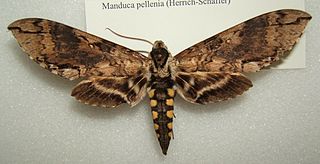
Manduca pellenia is a moth of the family Sphingidae. It is known from Mexico, Belize, Guatemala, Nicaragua, Costa Rica, Panama, Colombia and Ecuador.
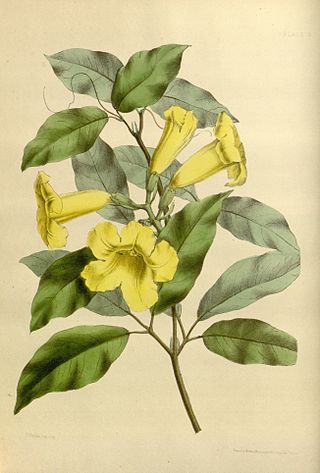
Adenocalymma is a genus of plants in the family Bignoniaceae. This New World genus of lianas contains approximately 93 accepted Species.

Adhemarius gannascus is a moth of the family Sphingidae first described by Caspar Stoll in 1790.

Enyo lugubris, the mournful sphinx, is a moth of the family Sphingidae. It is found from Argentina and Paraguay to Uruguay, Venezuela, Guyana, Suriname, French Guiana, Colombia, Ecuador, Peru, Brazil and the West Indies through Belize, Guatemala, Honduras, El Salvador, Nicaragua, Costa Rica and Panama to Mexico and the United States, where it has been recorded from Arizona east to Florida and north to South Carolina. Strays have been recorded from Arkansas, north to Illinois, Michigan and New York.

Eumorpha triangulum is a moth of the family Sphingidae.
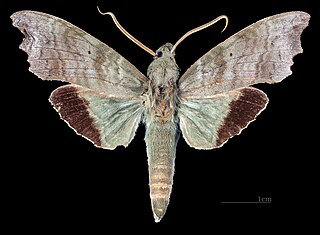
Aleuron chloroptera is a moth of the family Sphingidae. It was described by Maximilian Perty in 1833, and is known from southern Mexico, Brazil, Belize, Guatemala, Nicaragua, Costa Rica, Colombia, Peru, Bolivia, Venezuela, Guyana, Suriname, French Guiana, Paraguay, Argentina and Ecuador. It is probably also present in Uruguay, Honduras, El Salvador and Panama.

Xylophanes titana is a moth of the family Sphingidae first described by Herbert Druce in 1878.
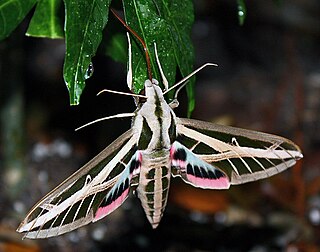
Eumorpha fasciatus, the banded sphinx, is a moth of the family Sphingidae. The species was first described by Johann Heinrich Sulzer in 1776.

Heliconius hecalesia, the five-spotted longwing, is a species of butterfly of the family Nymphalidae. It is found from Central America to Venezuela and Ecuador.

Prepona laertes, the shaded-blue leafwing or Laertes prepona, is a butterfly of the family Nymphalidae. It is found in large parts of Central and South America.

Hypothyris lycaste is a species of butterfly of the family Nymphalidae. It is found in Central and northern South America.
Anypsipyla is a monotypic snout moth genus described by Harrison Gray Dyar Jr. in 1914. Its only species, Anypsipyla univitella, was described by the same author in the same year. It is found in Central America, South America and has also been recorded from Cuba, Mexico, Jamaica and Florida in the southern United States.

Neoleucinodes elegantalis is a moth of the family Crambidae described by Achille Guenée in 1854. It ìs found in Mexico, Costa Rica, Cuba, Honduras, Grenada, Guatemala, Jamaica, Panama, Puerto Rico, Trinidad and Tobago, Argentina, Brazil, Colombia, Ecuador, Guyana, Paraguay, Peru, Suriname, Uruguay and Venezuela.
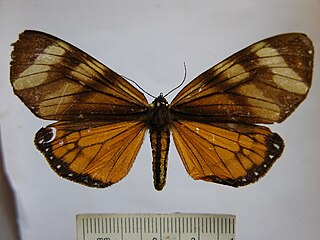
Dysschema eurocilia is a moth of the family Erebidae first described by Pieter Cramer in 1777. It is a common species throughout tropical America, where it has been recorded from the Antilles, Central America and South America.
Neoleucinodes prophetica, the potato tree borer, is a moth in the family Crambidae. It was described by Harrison Gray Dyar Jr. in 1914. It is found in Puerto Rico, Cuba, Jamaica, the Dominican Republic, Guatemala, Costa Rica, Panama, Honduras, Peru, Venezuela, Colombia, Trinidad and Tobago and Brazil. It is also present in southern Florida.
Dalcerides alba is a moth in the family Dalceridae. It was described by Herbert Druce in 1887. It is found in southern Mexico, Guatemala, Honduras, Belize, Costa Rica, Panama, Colombia and Ecuador.
Dalcerides mesoa is a moth in the family Dalceridae. It was described by Herbert Druce in 1887. It is found in southern Mexico, Guatemala, Costa Rica, Panama, Colombia, Venezuela and Ecuador.

Hamadryas iphthime, the ringless blue cracker or brownish cracker, is a species of cracker butterfly in the family Nymphalidae. It was first described by Henry Walter Bates in 1864. It is found in Mexico, Central America and parts of northern South America.















